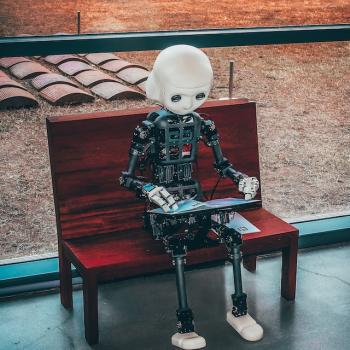I have been reading a most fascinating book, Cynthia Stokes Brown’s Big History: From the Big Bang to the Present. The book is by no means flawless. Her account of what we would call recorded history is sometimes shallow, and tinged with a typical secular distaste for religion, especially Christianity. But her account of the history of creation until this point is what caught my attention.
Let’s recall the basic story. The universe came into existence 13.7 billion years ago as a single point, as has been continuously expanding since then. As Brown describes it, it erupted from a single point, perhaps the size of an atom, in which matter and energy were squeezed together in unimaginable density. Then came the big bang, the spark of creation. For 9 billion years, the universe consisted of “celestial fireworks”. Out sun emerged about 4.6 billion years ago after a supernova exploded. As the planets formed, earth was different. Only earth has a size to produce a gravitational and electromagnetic balance, allowing a solid crust around a burning core. Only earth has a distance from the sun that allows complex molecules to form.
Life began around 3.8 billion years ago. For the next 2 billion years, bacteria owned the earth, and at the end of this period (about 1.8 billion years ago), they covered the entire surface. Around this time, oxygen began to increase, reaching 21 percent of the atmosphere. This is where it gets interesting, for that rate is highly significant: slightly lower, and organisms would asphyxiate, while slightly higher, and they would combust. Brown regards this as a “mystery”. Bacteria adapted well to the new atmosphere, and cells became ever more complicated. Bear in mind that five-sixth of the history of life on earth is simply the history of bacteria. Plant spores emerged about 460 million years ago and animals came ashore around the same time.
We also need to consider how the earth was changing, as the earth’s crust is carried on top of moving magma at speed measured at inches per year. But we are talking about long time periods. About 250 million years ago, all the land on earth had fused together into one huge mass called Pangaea, covered by ferns. Before this, land had floated on fragmented islands, and much of it was submerged, but it had possibly been one land mass at some point in the even more distant past. Pangaea lasted 50 million years. The continental plates are still moving. After Pangaea had split up, trees made their appearance, around 100 million years ago. Around 250 million years ago, there was a mass extinction and 95 percent of species were lost. Likely candidates for this first of many mass extinctions include climate change or extraterrestrial impacts. Indeed, the fusing of the continents into Pangaea may have provoked this severe climate change.
After the extinction, the dinosaurs arose to rule the world, rising to dominance around 210 million years ago, before Pangaea started breaking up. They ruled for over almost 150 million years, until they disappeared in yet another mass extinction that took place 65 million years ago. Just as dinosaurs benefited from the previous extinction, now was the turn of mammals. Apes emerged around 25 million years ago. Apes and humans began to diverge around 5 million years ago.
Finally, between 250,000 and 130,000 years ago, human beings finally made their first appearance. The current scientific consensus holds that a genetic mutation produced homo sapiens, and this mutation began with a single person. Something happened as the population expanded, some kind of bottleneck that could possible explain our uniformity, unique in nature. Homo sapiens left Africa and reached Europe about 50,000 years ago—during the Great Ice Age—and North America between 12,000-30,000 years ago.
In that time, human beings have remained one species, one people. Alone among all other species, human beings have the capacity for speech and for rational, abstract, and symbolic thought. In recent years, science—focused on the biological determinants of human behavior—is coming to an ever greater realization that we are really the same, that that differences based on skin color are utterly superficial. All human beings developed a complex, symbolic language. People are not solitary, and form patterns of socialization and kinship. A key human universal, unique to human beings, is the awareness of self. What makes us look different is no more than tiny and insignificant genetic effects. The concept of “race” is socially constructed and biologically meaningless. We are new, we are young, we are distinct, and we are one.
The scale of this history is sometimes difficult to grasp. But consider a new natural experiments. Imagine the universe began 13 years ago. In that case, earth would be 5 years old. Large organisms would have been around for 7 months. The dinosaurs were killed off 3 weeks ago. Homo sapiens is 53 minutes old. Recorded civilization existed for 3 minutes. Or if we assume the earth is a single day, then the first life appeared at 4am. The first sea plant did not arise until 8.30 pm that evening. Plants and animals would get to land around 10pm, and dinosaurs show up only at 11pm. They vanish at 20 minutes before midnight, and humans only make an appearance at two minutes before midnight.
I believe this narrative has profound theological implications, especially from the point of view of revealed truth. First, the history of the emerging universe immediately connotes the core doctrine of creatio ex nihilo, creation from nothingness. Before the big bang, there was nothing. After the big bang, there was creation, and we are part of that creation. Our existence owes everything to that spark of creation, 13.7 billion years ago. I think it is also clear that Gnostic theories of creation do not appear rational, as there is a discrete separation between the infinite creator and everything in creation. We are not sparks of the divine, but we are (in the slightly dated language of Brown) all made of stardust. Considering this account of creation also allows us to ponder the notion of an infinite God, how little we can understand, and small we are in the larger scheme of things. These are unfathomable mysteries. It simply boggles the mind that people like Richard Dawkins, experts in this area of science, can be so dismissive of religious claims. How do they understand infinity and creation? Why are they so willing to accept the “mysteries” of the unique position of the earth and the unique balance of oxygen that sustains life on earth, but refuse to accept the notion of a creator? How can it be rational to view this dazzling and awe-inspiring narrative as something entirely random? Truth cannot contradict truth, and the more truths we learn from history, the more confident I feel that the doctrines of our faith are true.
And what about human beings? Again, science shows that we are unique, are endowed with rationality, and have a consciousness, a sense of self. But again, the response of any theologian would surely be—duh! Aquinas was very clear that humans are substances (stardust!), animals, and (uniquely) rational creatures. It is a short leap to accepting the truth that human beings are created in the image and likeness of God. We are special. Science tells us that we are special, unique, and one people; revelation confirms it. We do not deserve to be special, but God nonetheless offers a share in the only life that is divine.
From the “big history” perspective, God became human only yesterday. As Brown is fond of pointing out, most species have a good run of a few million years. We are still young, and as infants, we have been adopted by God. We often think that the Church has been around for a long time, and feel quite divorced from the experiences of the early Christians. But, looking at the bigger picture, what if the Church is still in its infancy? What if the experience of Nicea to today are all teething problems over a much longer history? What if we need to look at the history of the Church as something that could enfold over tens of thousands, hundreds of thouands, even millions of years? The implications of this are simply astounding. It certainly puts all our current problems in perspective!












